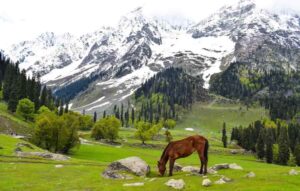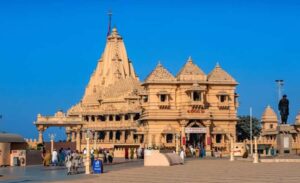History of Shri Mata Vaishno Devi Temple
The story of Vaishno Devi, one of the most revered goddesses in Hinduism, is steeped in history, mythology, and legends. Nestled in the Trikuta Mountains of the Indian state of Jammu and Kashmir, the Vaishno Devi shrine attracts millions of devotees each year. This pilgrimage site is not only a testament to faith but also a repository of captivating tales that have been passed down through generations.

Historical Origins
The historical origins of Vaishno Devi’s worship date back to the Mahabharata era, around 3200 BCE. While concrete historical records are scarce, the existence of the deity can be traced through inscriptions, literature, and folklore. Vaishno Devi’s worship became more prominent during the medieval period.
The earliest references to Vaishno Devi can be found in the Vedas, which mention her as a form of the Mother Goddess. Over the centuries, various dynasties, including the Mughals and Dogras, played a role in shaping the temple complex and its surroundings.
Mythology of Vaishno Devi
The mythology of Vaishno Devi revolves around the divine manifestation of the Mother Goddess. The most popular narrative can be traced to the Hindu epic, the Mahabharata.
1. Birth of Vaishno Devi
According to legend, Vaishno Devi was born as a mortal named Trikuta to a virtuous Brahmin named Ratnakar. From a young age, Trikuta displayed a deep devotion to Lord Vishnu. Her unwavering faith caught the attention of a sage named Rishi Bhagirath, who recognized her divine origins.
2. Trikuta’s Penances
To seek union with Lord Vishnu, Trikuta embarked on a rigorous penance in the Trikuta Mountains, where she meditated for centuries. She subsisted on leaves, fruits, and roots, all while enduring the harsh weather of the mountains.
3. Bhairon’s Pursuit
The demon king Bhairon Nath, who was smitten by Trikuta’s beauty, sought her hand in marriage. When she refused his proposal, Bhairon became obsessed and decided to marry her by force. Trikuta fled deeper into the mountains to escape him.
4. Transformation into Goddess
As Bhairon relentlessly pursued her, Trikuta prayed to Lord Vishnu for protection. In response to her plea, she transformed into a divine, powerful form, known as Vaishno Devi. Armed with celestial weapons, she confronted Bhairon.
5. Battle with Bhairon
A fierce battle ensued between Vaishno Devi and Bhairon. She displayed her immense power and defeated him, ultimately beheading him. Realizing his folly, Bhairon sought forgiveness with his dying breath, and Vaishno Devi forgave him.
6. Return to Meditation
After vanquishing Bhairon, Vaishno Devi returned to her form as Trikuta and continued her meditation. She lived in seclusion, and her divine aura attracted pilgrims, who began to build a shrine in her honor.
Legends and Folklore
Apart from the core mythology, there are several legends and folklore associated with Vaishno Devi:
1. Ardaas of Pandit Sridhar
One popular story tells of a devout devotee named Pandit Sridhar, who performed an ardaas (prayer) in front of the goddess. He expressed his wish to have a darshan (sight) of the goddess in the form of a young girl. Vaishno Devi, in her compassionate form, granted his wish and appeared as a young girl, fulfilling his lifelong desire.
2. The Call of the Divine
It is said that those who are destined to visit Vaishno Devi receive a divine call or summons, compelling them to undertake the arduous journey. This mystical phenomenon has drawn countless pilgrims from all walks of life.
3. The Holy Pind
The sanctum sanctorum of Vaishno Devi’s shrine houses the Holy Pind, a rock formation representing the goddess. It is believed that the Pind embodies her divine presence and that worshipping it fulfills devotees’ wishes.
Significance of Vaishno Devi
Vaishno Devi holds a special place in the hearts of her devotees for several reasons:
1. Symbol of Feminine Power
The legend of Vaishno Devi highlights the strength and power of the feminine divine. She is revered as the embodiment of Shakti (divine feminine energy) and is often associated with Goddess Mahakali, Mahalakshmi, and Mahasaraswati.
2. Fulfiller of Desires
Devotees believe that Vaishno Devi fulfills the wishes of those who visit her with pure hearts. Pilgrims come from far and wide to seek her blessings and have their desires granted.
3. Pilgrimage of Faith
The journey to Vaishno Devi’s shrine is considered a pilgrimage of immense faith and devotion. The treacherous terrain, steep climbs, and varying weather conditions test the determination of pilgrims.
Conclusion
The history, mythology, and legends surrounding Vaishno Devi are a testament to the enduring devotion of millions of Hindus. This sacred pilgrimage site continues to inspire faith, drawing people from diverse backgrounds. The story of Vaishno Devi, from her mortal beginnings to her divine transformation, serves as a source of spiritual strength and belief in the power of the divine feminine.
In the heart of the Trikuta Mountains, Vaishno Devi’s shrine remains a symbol of unwavering faith and devotion, where devotees seek blessings, redemption, and fulfillment of their deepest desires.
- Suggested to Read: History of Kedarnath Temple





